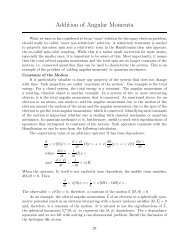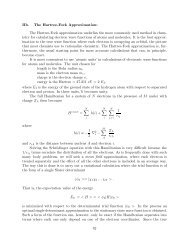The Role of Violent Video Game Content in
The Role of Violent Video Game Content in
The Role of Violent Video Game Content in
Create successful ePaper yourself
Turn your PDF publications into a flip-book with our unique Google optimized e-Paper software.
Journal <strong>of</strong> Adolescent<br />
Research<br />
http://jar.sagepub.com<br />
<strong>The</strong> <strong>Role</strong> <strong>of</strong> <strong>Violent</strong> <strong>Video</strong> <strong>Game</strong> <strong>Content</strong> <strong>in</strong> Adolescent<br />
Development: Boys' Perspectives<br />
Cheryl K. Olson, Lawrence A. Kutner and Dorothy E. Warner<br />
Journal <strong>of</strong> Adolescent Research 2008; 23; 55<br />
DOI: 10.1177/0743558407310713<br />
<strong>The</strong> onl<strong>in</strong>e version <strong>of</strong> this article can be found at:<br />
http://jar.sagepub.com/cgi/content/abstract/23/1/55<br />
Published by:<br />
http://www.sagepublications.com<br />
Additional services and <strong>in</strong>formation for Journal <strong>of</strong> Adolescent Research can be found at:<br />
Email Alerts: http://jar.sagepub.com/cgi/alerts<br />
Subscriptions: http://jar.sagepub.com/subscriptions<br />
Repr<strong>in</strong>ts: http://www.sagepub.com/journalsRepr<strong>in</strong>ts.nav<br />
Permissions: http://www.sagepub.com/journalsPermissions.nav<br />
Citations http://jar.sagepub.com/cgi/content/refs/23/1/55<br />
Downloaded from<br />
http://jar.sagepub.com at Iceland Telecom on February 16, 2009
<strong>The</strong> <strong>Role</strong> <strong>of</strong> <strong>Violent</strong> <strong>Video</strong><br />
<strong>Game</strong> <strong>Content</strong> <strong>in</strong> Adolescent<br />
Development<br />
Boys’ Perspectives<br />
Cheryl K. Olson<br />
Lawrence A. Kutner<br />
Dorothy E. Warner<br />
Massachusetts General Hospital<br />
Journal <strong>of</strong> Adolescent<br />
Research<br />
Volume 23 Number 1<br />
January 2008 55-75<br />
© 2008 Sage Publications<br />
10.1177/0743558407310713<br />
http://jar.sagepub.com<br />
hosted at<br />
http://onl<strong>in</strong>e.sagepub.com<br />
Numerous policies have been proposed at the local, state, and national level<br />
to restrict youth access to violent video and computer games. Although studies<br />
are cited to support policies, there is no published research on how<br />
children perceive the uses and <strong>in</strong>fluence <strong>of</strong> violent <strong>in</strong>teractive games. <strong>The</strong><br />
authors conduct focus groups with 42 boys ages 12 to 14. Boys use games to<br />
experience fantasies <strong>of</strong> power and fame, to explore and master what they perceive<br />
as excit<strong>in</strong>g and realistic environments (but dist<strong>in</strong>ct from real life), to<br />
work through angry feel<strong>in</strong>gs or relieve stress, and as social tools. Boys did<br />
not believe they had been harmed by violent games but were concerned that<br />
younger children might imitate game behavior (especially swear<strong>in</strong>g).<br />
Keywords: video games; focus groups; media violence; adolescence; gender;<br />
anger<br />
Young adolescents have <strong>in</strong>creas<strong>in</strong>g access to electronic <strong>in</strong>teractive<br />
games on game consoles, handheld players, computers, the Internet,<br />
and cellular phones. National surveys <strong>of</strong> American youth ages 8 to 18 by<br />
the Kaiser Family Foundation (Roberts, Foehr, & Rideout, 2005) found that<br />
<strong>in</strong> 2005, 49% <strong>of</strong> children had a game console <strong>in</strong> their bedroom (up from<br />
Authors’ Note: This research was supported by Grant No. 2003-JN-FX-0078 awarded by the<br />
Office <strong>of</strong> Juvenile Justice and Del<strong>in</strong>quency Prevention, Office <strong>of</strong> Justice Programs, U.S.<br />
Department <strong>of</strong> Justice. We thank Molly R. Butterworth, Cather<strong>in</strong>e C. Garth, and George C.<br />
Nitzburg for their assistance with data collection; Sarah M. Hertzog for her role <strong>in</strong> data review;<br />
and Danielle DeLuca for her assistance with manuscript preparation. Please address correspondence<br />
to Cheryl K. Olson, Center for Mental Health and Media, Massachusetts General<br />
Hospital Department <strong>of</strong> Psychiatry, Wang 812, Parkman Street, Boston, MA 02114; e-mail:<br />
ckolson@partners.org.<br />
Downloaded from<br />
http://jar.sagepub.com at Iceland Telecom on February 16, 2009<br />
55
56 Journal <strong>of</strong> Adolescent Research<br />
45% <strong>in</strong> 1999), 31% had a computer (up from 21% <strong>in</strong> 1999), and 20% had<br />
Internet access (up from 10% <strong>in</strong> 1999). European surveys also show that<br />
new media, <strong>in</strong>clud<strong>in</strong>g electronic games, are part <strong>of</strong> children’s everyday life<br />
(Roe, 2000).<br />
<strong>The</strong> widespread prevalence <strong>of</strong> this type <strong>of</strong> play across most <strong>in</strong>dustrialized<br />
nations makes it normative (Warner & Raiter, 2005). However, many<br />
parents, cl<strong>in</strong>icians, researchers, and policy makers are concerned that electronic<br />
games, especially those featur<strong>in</strong>g violent content, may be harmful to<br />
youth. Researchers have fiercely debated the applicability <strong>of</strong> the literature<br />
on effects <strong>of</strong> violent video game content to real-world behaviors (Vastag,<br />
2004). To further our understand<strong>in</strong>g <strong>of</strong> the ways <strong>in</strong> which video game play,<br />
risky behavior, and healthy development may be related, it is useful to consider<br />
the perspectives <strong>of</strong> adolescents themselves.<br />
Prevalence <strong>of</strong> <strong>Video</strong> <strong>Game</strong> Play<br />
Almost all boys and most girls play video and computer games, <strong>in</strong>clud<strong>in</strong>g<br />
games with violent content. A Kaiser Family Foundation survey<br />
(Roberts et al., 2005) found that 77% <strong>of</strong> boys <strong>in</strong> Grades 7 to 12 had played<br />
a game <strong>in</strong> the Grand <strong>The</strong>ft Auto series (Rockstar Enterta<strong>in</strong>ment), and nearly<br />
half (49%) had played a game <strong>in</strong> the popular Madden NFL series<br />
(Electronic Arts). In a recent study <strong>of</strong> middle school students’ media habits<br />
(Olson et al., 2007), 94% reported hav<strong>in</strong>g played computer or video games<br />
dur<strong>in</strong>g the preced<strong>in</strong>g 6 months. Of those who played electronic games, one<br />
third <strong>of</strong> boys and 11% <strong>of</strong> girls said they played nearly every day; 49% had<br />
played at least one Mature-rated title (<strong>in</strong>tended for players age 17 and<br />
older) “a lot” <strong>in</strong> the previous 6 months. Data collected <strong>in</strong> the late 1990s <strong>in</strong><br />
10 European countries and Israel found that children ages 6 to 16 averaged<br />
more than a half hour per day on electronic video and computer games<br />
(Beentjes, Koolstra, Marseille, & van der Voort, 2001).<br />
Concerns About Effects <strong>of</strong> <strong>Violent</strong> <strong>Game</strong> <strong>Content</strong><br />
Researchers, cl<strong>in</strong>icians, and policy makers have expressed concern that<br />
the violence children see <strong>in</strong> video and computer games could carry over<br />
<strong>in</strong>to the real world as aggressive behavior or thoughts, desensitization to<br />
violence, and decreased empathy (Funk, 2005). <strong>The</strong>y fear that the greater<br />
immersion and <strong>in</strong>teractivity <strong>of</strong> video games, compared to passive media<br />
Downloaded from<br />
http://jar.sagepub.com at Iceland Telecom on February 16, 2009
Olson et al. / <strong>Violent</strong> <strong>Video</strong> <strong>Game</strong>s and Adolescent Boys 57<br />
such as television, could blur players’ perceptions <strong>of</strong> the boundaries between<br />
fantasy and reality (American Psychological Association, 2005; Calvert &<br />
Tan, 1994). Furthermore, repeated act<strong>in</strong>g out <strong>of</strong> “aggressive scripts” with<strong>in</strong><br />
violent game scenarios might lead to automatic aggressive responses to perceived<br />
provocations <strong>in</strong> the real world (Funk, 2005). Some reviews <strong>of</strong> research<br />
assert that exist<strong>in</strong>g data support a large and consistent effect <strong>of</strong> violent games<br />
on aggressive thoughts, feel<strong>in</strong>gs, and behaviors (Anderson, 2004). Other<br />
reviews conclude that any harmful effects <strong>of</strong> <strong>in</strong>teractive games are small or<br />
evidence is mixed and that more study is needed (Bensley & van Eenwyk,<br />
2001; Browne & Hamilton-Giachritsis, 2005; Sherry, 2001).<br />
Academics and policy makers <strong>in</strong> the United States (Anderson, 2004)<br />
and, most recently, <strong>in</strong> Germany (Dobson, 2006) have cited anecdotal<br />
reports l<strong>in</strong>k<strong>in</strong>g violent video games to highly publicized violent crimes<br />
such as school shoot<strong>in</strong>gs. However, these reports <strong>of</strong>ten neglect other known<br />
contributors to violence. For example, the attorney for Lee Malvo, the adolescent<br />
charged with a series <strong>of</strong> fatal sniper shoot<strong>in</strong>gs <strong>in</strong> the Wash<strong>in</strong>gton,<br />
D.C., area <strong>in</strong> 2002, cited his exposure to violent video games <strong>in</strong> his defense.<br />
Yet the young man had a history <strong>of</strong> parental abandonment, poverty, animal<br />
torture, and violent attacks with weapons (Liptak, 2003; Miller, 2003).<br />
After the Columb<strong>in</strong>e High School murders, the U.S. Secret Service<br />
reviewed a quarter century <strong>of</strong> school-based attacks. <strong>The</strong> report did not s<strong>in</strong>gle<br />
out violent media use as a contributor to school shoot<strong>in</strong>gs (Vossekuil,<br />
Fe<strong>in</strong>, Reddy, Borum, & Modzeleski, 2002). Furthermore, although the<br />
majority <strong>of</strong> adolescent boys now play violent video games, juvenile violent<br />
crime (<strong>in</strong>clud<strong>in</strong>g murder) has steadily decl<strong>in</strong>ed <strong>in</strong> the United States; arrest<br />
rates are down 49% from their 1994 peak, reach<strong>in</strong>g their lowest level s<strong>in</strong>ce<br />
at least 1980 (Snyder, 2006).<br />
More study is needed on the possibility that video games and other<br />
media with violent content could have less visible but still significant harmful<br />
effects on children’s behavior. For example, certa<strong>in</strong> types or amounts <strong>of</strong><br />
video game play could affect emotions, cognition, perceptions, and behaviors<br />
<strong>in</strong> ways that promote bully<strong>in</strong>g and victimization (Olson, 2004).<br />
<strong>The</strong> many well-established risk factors for aggressive or violent behavior<br />
<strong>in</strong>clude <strong>in</strong>dividual characteristics, such as neurological damage, <strong>in</strong>secure<br />
attachment, and parental neglect or abuse, as well as exposure to social<br />
problems, such as poverty and neighborhood violence. <strong>The</strong>se risk factors<br />
are complicated and <strong>in</strong>terwoven over time such that it is impossible to identify<br />
one specific cause <strong>of</strong> aggressive or violent behavior. Evidence <strong>of</strong> harm<br />
from media with violent content is less clear cut (U.S. Department <strong>of</strong><br />
Health and Human Services, 2001).<br />
Downloaded from<br />
http://jar.sagepub.com at Iceland Telecom on February 16, 2009
58 Journal <strong>of</strong> Adolescent Research<br />
However, even if effects are small, exposure to violence through electronic<br />
media is one risk factor that could potentially be modified. It is therefore<br />
important to understand which types <strong>of</strong> media content, <strong>in</strong>clud<strong>in</strong>g<br />
various video game genres, have potential to negatively affect arousal, cognition,<br />
emotions, and behavior. Equally important, we must look for differ<strong>in</strong>g<br />
effects among subgroups <strong>of</strong> children, such as those who have aggressive<br />
temperaments or exposure to family or neighborhood violence (Browne &<br />
Hamilton-Giachritsis, 2005), and consider factors related to play patterns<br />
and sett<strong>in</strong>gs, <strong>in</strong>clud<strong>in</strong>g game preferences and time spent play<strong>in</strong>g, which<br />
might serve as markers for behavioral or emotional problems.<br />
Electronic <strong>Game</strong> Play and Healthy Development<br />
Although most research on video games has emphasized harm, some surveys<br />
<strong>of</strong> adolescents have found l<strong>in</strong>ks between <strong>in</strong>teractive game play and social<br />
and emotional well-be<strong>in</strong>g (Colwell & Kato, 2003; Durk<strong>in</strong> & Barber, 2002).<br />
Researchers have theorized that video games—perhaps <strong>in</strong>clud<strong>in</strong>g those with<br />
violent content—may have benefits for adolescents (Gelfond & Salonius-<br />
Pasternak, 2005; Goldste<strong>in</strong>, 2000; Griffiths, 2003; Kirsh, 2003; McNamee,<br />
2000; Sherry, 2001). As adolescents explore different roles and social situations,<br />
<strong>in</strong>clud<strong>in</strong>g the <strong>in</strong>evitable conflicts with peers and parents, they create,<br />
break, and negotiate rules. By provid<strong>in</strong>g adolescents with situations not typically<br />
experienced <strong>in</strong> the real world, video game play may facilitate exploration<br />
<strong>of</strong> rules and consequences (Scarlett, Naudeau, Salonius-Pasternak, & Ponte,<br />
2004). <strong>Violent</strong> games are also a safe place to experiment with emotions and<br />
roles that may be unacceptable <strong>in</strong> daily life (Jansz, 2005). Interviews with adolescents<br />
and young adults suggest that many view violent video games as <strong>in</strong>corporat<strong>in</strong>g<br />
realistic situations and consequences (Malliet, 2006).<br />
Some researchers posit that older children and adolescents understand that<br />
violent video game play is simply a form <strong>of</strong> play; they dist<strong>in</strong>guish fantasy<br />
aggression and violence from real-world behavior that <strong>in</strong>cludes <strong>in</strong>tent to harm<br />
a real victim (Goldste<strong>in</strong>, 2001; Malliet, 2006). Accord<strong>in</strong>g to catharsis theory,<br />
play<strong>in</strong>g violent video games could provide a safe outlet for aggressive and<br />
angry feel<strong>in</strong>gs (Griffiths, 2000). Others have criticized this idea, cit<strong>in</strong>g a lack<br />
<strong>of</strong> empirical support <strong>in</strong> television studies (Dill & Dill, 1998; Huesmann &<br />
Taylor, 2003). Research on elementary-age boys found that aggressive motoric<br />
activity (e.g., throw<strong>in</strong>g a ball at a draw<strong>in</strong>g <strong>of</strong> a frown<strong>in</strong>g face) could reduce<br />
levels <strong>of</strong> fantasy aggression (Murray & Feshbach, 1978). Unlike television,<br />
video games allow player-directed act<strong>in</strong>g out <strong>of</strong> aggressive fantasies, and<br />
Downloaded from<br />
http://jar.sagepub.com at Iceland Telecom on February 16, 2009
Olson et al. / <strong>Violent</strong> <strong>Video</strong> <strong>Game</strong>s and Adolescent Boys 59<br />
new game controllers allow an <strong>in</strong>creas<strong>in</strong>g amount <strong>of</strong> physical <strong>in</strong>teraction.<br />
<strong>The</strong> potential l<strong>in</strong>k between violent video games and catharsis merits further<br />
exploration.<br />
<strong>Video</strong> game play may serve particular needs <strong>of</strong> adolescent boys with<br />
regard to aggression and socialization. In this period <strong>of</strong> development, boys<br />
use rough-and-tumble play to explore aggression, establish<strong>in</strong>g peer status<br />
by focus<strong>in</strong>g on dom<strong>in</strong>ance rather than caus<strong>in</strong>g physical harm to participants<br />
(Pellegr<strong>in</strong>i, 2003; Pellegr<strong>in</strong>i & Smith, 1998). It is possible that adolescent<br />
boys achieve some <strong>of</strong> these goals through their video game play. Rather<br />
than encourag<strong>in</strong>g aggressive or violent behavior, video game play may help<br />
adolescent boys consider issues <strong>of</strong> war, violence, and death (Gelfond &<br />
Salonius-Pasternak, 2005). As with physical activity play, some adolescents<br />
may engage with video games <strong>in</strong> a dysfunctional manner.<br />
Adolescents’ Perspectives on <strong>Video</strong> <strong>Game</strong> Play<br />
Our understand<strong>in</strong>g <strong>of</strong> these complex relations, as well as any policy or<br />
legislation that may be implemented, should be <strong>in</strong>formed by adolescents’<br />
own perspectives on their video game play. This <strong>in</strong>cludes recogniz<strong>in</strong>g the<br />
personal, social, and emotional goals boys have for game play; their perceptions<br />
<strong>of</strong> game characters and actions; and the context <strong>of</strong> game play<br />
(Sherry, 2001; Williams, 2005). To date, no published studies have exam<strong>in</strong>ed<br />
young adolescents’ descriptions <strong>of</strong> why they play video games, what<br />
leads them to choose games with violent content, and how they perceive the<br />
<strong>in</strong>fluence <strong>of</strong> games on themselves and their peers. To beg<strong>in</strong> address<strong>in</strong>g this<br />
gap, we conducted focus groups with young adolescent boys.<br />
We chose to focus on young adolescents for several reasons. <strong>The</strong>y may be<br />
more vulnerable to the <strong>in</strong>fluence <strong>of</strong> violent content dur<strong>in</strong>g this stage <strong>of</strong> cognitive,<br />
emotional, social, and neurological development (Kirsh, 2003). <strong>The</strong>y are<br />
more likely to engage <strong>in</strong> risky behavior, especially with peers, and less able to<br />
assess the consequences <strong>of</strong> those behaviors (Gardner & Ste<strong>in</strong>berg, 2005). <strong>The</strong><br />
potential effects <strong>of</strong> game violence on aggressive behavior is a central concern,<br />
and the prevalence <strong>of</strong> externaliz<strong>in</strong>g problems tends to peak <strong>in</strong> midadolescence<br />
(Ste<strong>in</strong>berg & Morris, 2001). F<strong>in</strong>ally, on a practical level, their activities are less<br />
subject to adult oversight than those <strong>of</strong> younger children.<br />
<strong>The</strong> current study was limited to boys. Boys are more likely than girls to<br />
play video games <strong>in</strong> general and action or combat games <strong>in</strong> particular; they are<br />
also far more likely to play games <strong>in</strong> the presence <strong>of</strong> multiple peers (Olson<br />
et al., 2007). Physically aggressive behavior is more common among boys<br />
Downloaded from<br />
http://jar.sagepub.com at Iceland Telecom on February 16, 2009
60 Journal <strong>of</strong> Adolescent Research<br />
than girls (Loeber & Hay, 1997). Also, research has shown considerable<br />
gender differences <strong>in</strong> the perception and expression <strong>of</strong> aggression (Galen &<br />
Underwood, 1997).<br />
We addressed the follow<strong>in</strong>g research questions:<br />
1. What do boys identify as the reasons they play violent video games? What<br />
attracts boys to particular games, or game characters? Can electronic games<br />
be fun without violent content?<br />
2. How do boys view the role <strong>of</strong> video games <strong>in</strong> social relationships?<br />
3. What <strong>in</strong>fluence do boys believe violent video games have on their thoughts,<br />
feel<strong>in</strong>gs, and behaviors and those <strong>of</strong> their peers? How do they believe violent<br />
games might affect younger children?<br />
Because these issues have been little explored, we also paid close attention<br />
to unanticipated themes that arose spontaneously <strong>in</strong> boys’ discussions.<br />
Participants<br />
Method<br />
We recruited 42 seventh- and eighth-grade boys ages 12 to 14. Two sets <strong>of</strong><br />
focus groups were conducted us<strong>in</strong>g similar protocols: concurrent groups (<strong>in</strong><br />
separate rooms) <strong>of</strong> 21 parents and sons, held <strong>in</strong> a suburban <strong>of</strong>fice build<strong>in</strong>g, and<br />
boys-only groups with 21 additional participants, held at three Boston-area<br />
clubs serv<strong>in</strong>g disadvantaged urban youth. For the parent/son groups, participants<br />
were recruited via an e-mail broadcast to more than 2,500 employees <strong>of</strong><br />
the Partners HealthCare System, as well as flyers posted <strong>in</strong> local bus<strong>in</strong>esses and<br />
near schools. For the boys-only groups, the youth clubs posted flyers for groups<br />
to be held at their facilities. (Additional f<strong>in</strong>d<strong>in</strong>gs from the parent/son groups are<br />
presented <strong>in</strong> a companion article titled “Parents’ and Sons’ Perspectives on<br />
<strong>Video</strong> <strong>Game</strong> Play: A Qualitative Study.”)<br />
Respondents were screened by telephone. To qualify, boys had to report<br />
play<strong>in</strong>g video or computer games at least 2 hours per week. We also<br />
required experience with two or more games from a list <strong>of</strong> eight bestsell<strong>in</strong>g<br />
violent games rated either “Teen” (ages 13 and older) or “Mature” (m; ages<br />
17 and older) by the Enterta<strong>in</strong>ment S<strong>of</strong>tware Rat<strong>in</strong>g Board. <strong>Game</strong>s were<br />
selected based on three criteria: availability on the <strong>in</strong>dustry-lead<strong>in</strong>g<br />
PlayStation 2 console (at m<strong>in</strong>imum), the popularity <strong>of</strong> the game (based on<br />
sales data), and the presence <strong>of</strong> violent content (shoot<strong>in</strong>g, fight<strong>in</strong>g, and/or<br />
blood). <strong>The</strong> Teen-rated titles used were Def Jam Vendetta, Soul Caliber II,<br />
and Tekken Tag Tournament. <strong>The</strong> Mature-rated games were Mortal Kombat:<br />
Downloaded from<br />
http://jar.sagepub.com at Iceland Telecom on February 16, 2009
Deadly Alliance, Grand <strong>The</strong>ft Auto 3, Grand <strong>The</strong>ft Auto: Vice City, Metal Gear<br />
Solid 2: Sons <strong>of</strong> Liberty,and Resident Evil: Code Veronica X.<br />
Potential participants were told that the groups would discuss adolescent<br />
video game play but were not <strong>in</strong>formed <strong>of</strong> the specific emphasis. <strong>Video</strong><br />
games were def<strong>in</strong>ed as games played on game consoles, computers, or<br />
handheld devices. <strong>The</strong> Partners HealthCare System/Massachusetts General<br />
Hospital human research committee approved the protocol and procedures.<br />
Participants came from 15 communities <strong>in</strong> the greater Boston area and<br />
represented a diverse mix <strong>of</strong> socioeconomic and racial/ethnic backgrounds.<br />
Each boy received $50 for his participation.<br />
Procedure<br />
Olson et al. / <strong>Violent</strong> <strong>Video</strong> <strong>Game</strong>s and Adolescent Boys 61<br />
We held eight focus groups with 42 boys, half concurrent with parent<br />
groups (conducted <strong>in</strong> a separate room) and half with boys only. Groups averaged<br />
four to five participants and lasted 75 to 90 m<strong>in</strong>utes. Boys gave written<br />
assent to participate, and a parent or guardian gave written consent. We made<br />
audio record<strong>in</strong>gs <strong>of</strong> all focus groups with the permission <strong>of</strong> the participants.<br />
A senior researcher and a research assistant moderated each group,<br />
work<strong>in</strong>g from a written list <strong>of</strong> research questions recast <strong>in</strong> open-ended, conversational<br />
language; standardized probe questions were used to elicit<br />
details (Stewart & Shamdasani, 1990). Moderators also asked follow-up<br />
questions about themes <strong>in</strong>troduced by participants. To stimulate conversation<br />
and provide a visual reference, pr<strong>in</strong>ted color images from the eight<br />
video games were displayed on the table. Although all <strong>of</strong> the games conta<strong>in</strong><br />
violence, only nonviolent screenshots were presented so that boys were not<br />
exposed to additional or novel violent content. To start the group discussion,<br />
each boy was asked to select a game screenshot from the table and to<br />
describe what he liked about his chosen game. After each boy had shared<br />
his op<strong>in</strong>ions, this process was repeated; the group then moved on to a<br />
broader discussion <strong>of</strong> issues related to video games.<br />
Boys were asked the follow<strong>in</strong>g:<br />
• What do you like about (name <strong>of</strong> video game)? What is your favorite part?<br />
What do you like to do?<br />
• Are there any characters <strong>in</strong> this game that you especially like? What is it<br />
about this character that you like?<br />
• What makes a video game good enough to play more than once? What makes<br />
a game excit<strong>in</strong>g for you?<br />
• Notice that all <strong>of</strong> the games we have talked about have violence <strong>in</strong> them:<br />
fight<strong>in</strong>g or shoot<strong>in</strong>g or blood. Do you th<strong>in</strong>k these make a game more fun?<br />
Downloaded from<br />
http://jar.sagepub.com at Iceland Telecom on February 16, 2009
62 Journal <strong>of</strong> Adolescent Research<br />
• Can a game be fun without violence? [If yes] What game do you have <strong>in</strong> m<strong>in</strong>d?<br />
[If no, or not sure] Can you th<strong>in</strong>k <strong>of</strong> any fun game that does not have violence?<br />
• Some people th<strong>in</strong>k that games with fight<strong>in</strong>g, shoot<strong>in</strong>g, or blood can affect the<br />
way kids behave. Do you th<strong>in</strong>k games like these can make kids act or th<strong>in</strong>k<br />
any different? Do you th<strong>in</strong>k you would be different if you had never played<br />
any violent games?<br />
• How do you feel while you are play<strong>in</strong>g a violent game, and how do you feel<br />
afterward? Give me an example (e.g., a game played yesterday). How did<br />
you feel before versus after?<br />
• Some kids play video games by themselves, some kids play video games<br />
with other people, and there are some kids who do both. What do you do?<br />
What do you like about play<strong>in</strong>g alone versus play<strong>in</strong>g with other people? Do<br />
you ever play with other people on the Web?<br />
• Have you ever made a new friend play<strong>in</strong>g video games? Do you ever feel that<br />
play<strong>in</strong>g video games keeps you from be<strong>in</strong>g with other people/gets <strong>in</strong> the way <strong>of</strong><br />
friendships? [Groups held at youth clubs spent more time on social questions.]<br />
• If you have a little brother or sister, are there games you would not want him or<br />
her to play? Why? Are there games that you th<strong>in</strong>k kids your age should not play?<br />
Data Analysis<br />
<strong>The</strong> pr<strong>in</strong>cipal <strong>in</strong>vestigator and co<strong>in</strong>vestigator (who were the primary group<br />
moderators), the research coord<strong>in</strong>ator, and another researcher reviewed full<br />
pr<strong>in</strong>t transcripts <strong>of</strong> group audio record<strong>in</strong>gs prepared by a research assistant.<br />
We identified and coded responses to the research questions and made marg<strong>in</strong>al<br />
notes on recurr<strong>in</strong>g themes <strong>in</strong> these responses as well as issues that<br />
emerged <strong>in</strong>dependently. We periodically conducted reliability checks dur<strong>in</strong>g<br />
this process to ensure consistency <strong>in</strong> <strong>in</strong>terpretation and cod<strong>in</strong>g term<strong>in</strong>ology<br />
among reviewers (Krueger, 1998; Miles & Huberman, 1994). After complet<strong>in</strong>g<br />
the <strong>in</strong>itial analyses, reviewers discussed their f<strong>in</strong>d<strong>in</strong>gs and compiled a<br />
document that <strong>in</strong>cluded each other’s notes, so that data analyses were both<br />
<strong>in</strong>dependent and collaborative. This process <strong>in</strong>corporated the recommendations<br />
suggested by Marshall and Rossman (1998) to establish and ma<strong>in</strong>ta<strong>in</strong><br />
credibility, transferability, dependability, and confirmability via discussions<br />
with other researchers.<br />
Results<br />
<strong>The</strong> follow<strong>in</strong>g results and illustrative comments are organized by<br />
research question, conclud<strong>in</strong>g with unexpected themes or topics that were<br />
not related to our a priori questions.<br />
Downloaded from<br />
http://jar.sagepub.com at Iceland Telecom on February 16, 2009
<strong>The</strong> Appeal <strong>of</strong> <strong>Violent</strong> <strong>Video</strong> <strong>Game</strong>s<br />
Olson et al. / <strong>Violent</strong> <strong>Video</strong> <strong>Game</strong>s and Adolescent Boys 63<br />
Our analyses suggest that boys are attracted to video and computer game<br />
play, and especially to violent games, for five clusters <strong>of</strong> reasons: (a) fantasies<br />
<strong>of</strong> power and fame; (b) challenge, exploration, and mastery; (c) emotional<br />
regulation, especially cop<strong>in</strong>g with anger and stress; (d) sociability<br />
(cooperation, competition, and status seek<strong>in</strong>g); and (e) learn<strong>in</strong>g new skills<br />
(particularly <strong>in</strong> the case <strong>of</strong> sports games).<br />
<strong>Game</strong>s and fantasies <strong>of</strong> power. Boys talked about play<strong>in</strong>g games with violent<br />
content as a way to express their fantasies <strong>of</strong> power and glory. Some boys<br />
described aspects <strong>of</strong> ma<strong>in</strong> characters’ skills, personalities, or appearance as<br />
someth<strong>in</strong>g with which they identify outside <strong>of</strong> the game. For example:<br />
What I like about [Grand <strong>The</strong>ft Auto] Vice City is, I like Tommy Vercetti<br />
because he never gives up and he never quits or anyth<strong>in</strong>g. And it’s played by<br />
Ray Liotta; he’s one <strong>of</strong> my favorite actors. (Boy 8)<br />
Boys also imag<strong>in</strong>ed what they would do if suddenly blessed with the abilities<br />
<strong>of</strong> a favorite game character. <strong>The</strong>se descriptions <strong>in</strong>cluded references to<br />
conflicts or problems they encountered <strong>in</strong> their lives:<br />
If I could be powerful like J<strong>in</strong>, when somebody’s gett<strong>in</strong>g bullied or someth<strong>in</strong>g,<br />
and they can’t defend themselves, I’d go help them out. (Boy 33)<br />
I wish I could be stronger, so if someone’s afraid <strong>of</strong> me—not that I want them<br />
to be afraid <strong>of</strong> me—but they won’t try to start someth<strong>in</strong>g with me. And I want<br />
to be famous. (Boy 39)<br />
If I were Sub-Zero, I would go to school, I would freeze my teacher and the<br />
pr<strong>in</strong>cipal, and all the other teachers. So the students could do whatever they<br />
want. <strong>The</strong>y could run <strong>in</strong> the hallways! (Boy 33)<br />
However, boys were also aware that game actions would have very different<br />
consequences <strong>in</strong> the real world. When asked what he would do if he woke up<br />
tomorrow as Mitsurugi from Tekken, one participant (Boy 4) said, “I don’t<br />
know, because if I took the sword out <strong>in</strong> public, then I’d get arrested!” Other<br />
boys made similar comments about Grand <strong>The</strong>ft Auto games:<br />
I’m k<strong>in</strong>d <strong>of</strong> scared to do that stuff. If I shoot somebody and they die, then I’ll<br />
go to jail for a long time, so I don’t want to do that. (Boy 34)<br />
Downloaded from<br />
http://jar.sagepub.com at Iceland Telecom on February 16, 2009
64 Journal <strong>of</strong> Adolescent Research<br />
<strong>The</strong> whole thug th<strong>in</strong>g seems k<strong>in</strong>d <strong>of</strong> cool, but <strong>in</strong> real life, I wouldn’t really<br />
want to have that life. In here, you don’t m<strong>in</strong>d just gett<strong>in</strong>g out <strong>of</strong> your car and<br />
kill<strong>in</strong>g somebody, because you’re not go<strong>in</strong>g to get <strong>in</strong> trouble for it. You can<br />
just turn <strong>of</strong>f the game system and you’re done. (Boy 10)<br />
Some boys mentioned special powers or weapons that they enjoyed us<strong>in</strong>g<br />
<strong>in</strong> the game; for example, Boy 14 said, “<strong>The</strong> swords <strong>in</strong> Mortal Kombat are<br />
fun to use; they look cool.” <strong>The</strong>se references did not <strong>in</strong>clude an <strong>in</strong>dication<br />
<strong>of</strong> identification or imitation outside <strong>of</strong> the game.<br />
<strong>Game</strong>s and exploration, challenge and mastery. To lead <strong>in</strong>to the topic <strong>of</strong><br />
violent games, boys were asked what made a game fun to play more than<br />
once. Many mentioned challenge, action, excitement, and the more <strong>in</strong>depth<br />
development <strong>of</strong> characters:<br />
I like adventure games because you don’t only play for 20 m<strong>in</strong>utes and then<br />
beat it. I like a game that takes time and focus-ness [sic] to do it. (Boy 23)<br />
And then you can do a whole different storyl<strong>in</strong>e and beat it aga<strong>in</strong>. Also, you<br />
could go explor<strong>in</strong>g. (Boy 27)<br />
When asked whether violence makes a game more fun, many boys agreed:<br />
It’s stuff that you can’t do <strong>in</strong> real life, like kill people. So you could just, like,<br />
go crazy with the games. (Boy 34)<br />
Others described games with violent content as hav<strong>in</strong>g more action or<br />
challenges:<br />
I like sports games a lot, and when I do play a violent game, it’s fun too,<br />
because I like the action and stuff. I th<strong>in</strong>k there’s a little more action <strong>in</strong> violence<br />
games [sic] than there is <strong>in</strong> nonviolence games. (Boy 24)<br />
I th<strong>in</strong>k a game could have no violence at all and still be really good, because<br />
I like the realism and the challenge and stuff. (Boy 26)<br />
Most boys felt that some types <strong>of</strong> games could be fun without violence.<br />
<strong>The</strong>y cited sports games, rac<strong>in</strong>g games, or older games such as Pac-Man,<br />
p<strong>in</strong>ball, or onl<strong>in</strong>e checkers. <strong>The</strong>y especially liked games with realistic<br />
sounds or actions, such as choos<strong>in</strong>g draft picks as a coach <strong>in</strong> Madden NFL.<br />
<strong>Game</strong>s and anger. Many boys described us<strong>in</strong>g violent games to cope<br />
with feel<strong>in</strong>gs <strong>of</strong> anger or frustration. This type <strong>of</strong> play served as an outlet<br />
for emotional expression or as a form <strong>of</strong> distraction. For example:<br />
Downloaded from<br />
http://jar.sagepub.com at Iceland Telecom on February 16, 2009
Olson et al. / <strong>Violent</strong> <strong>Video</strong> <strong>Game</strong>s and Adolescent Boys 65<br />
Gett<strong>in</strong>g wrapped up <strong>in</strong> a violent game, it’s good. ’Cause if you mad, when you<br />
come home, you can take your anger out on the people <strong>in</strong> the game. (Boy 32)<br />
If I had a bad day at school, I’ll play a violent video game and it just relieves<br />
all my stress. (Boy 12)<br />
Last week, I missed one homework and my teacher yelled at me. . . . When I<br />
went home, I started play<strong>in</strong>g Vice City and I did a cheat code to get a tank<br />
and I ran over everybody. And I smashed a lot <strong>of</strong> cars and blew them up. . . .<br />
I was mad, and I turned happy afterwards. (Boy 34)<br />
One boy described cop<strong>in</strong>g with a real-life conflict by role-play<strong>in</strong>g it <strong>in</strong> the<br />
game:<br />
Say some kid wants to fight you, and he talks trash about you. When you go<br />
home and play, you’re like, “This is the kid that I hate,” and you beat him up<br />
and stuff. (Boy 39)<br />
When asked if play<strong>in</strong>g the game might help him avoid a fight, the boy said:<br />
Maybe. ’Cause if I don’t play a game or if I don’t do noth<strong>in</strong>g, it gets me even<br />
angrier, real mad. If I play a game, it’s, “All right, I beat him.” <strong>The</strong>n, it feels<br />
like I really did someth<strong>in</strong>g and I’m done, man. (Boy 39)<br />
<strong>Game</strong>s as social tools. For many boys, video games are a focus <strong>of</strong> social<br />
activities and discussions:<br />
Usually me and my friends, when we’re over at each others’ houses, and they<br />
have a good game [we’ll play it]. <strong>The</strong>y’re like, “Oh, I’ll kill you <strong>in</strong> Madden<br />
2005.” It’s fun to beat them. (Boy 15)<br />
If I didn’t play video games—it’s k<strong>in</strong>d <strong>of</strong> a topic <strong>of</strong> conversation, and so I don’t<br />
know what I’d talk about. ’Cause I talk about video games a lot. (Boy 4)<br />
Several boys noted that talk<strong>in</strong>g about video game play helped them structure<br />
<strong>in</strong>itial conversations with potential or new friends:<br />
You say, “Do you own a system, a game system?” If he says yes, then, “What<br />
k<strong>in</strong>d? PS2, <strong>Game</strong>cube, Xbox?” Like that. (Boy 28)<br />
A number <strong>of</strong> boys mentioned play<strong>in</strong>g games over the Internet, sometimes<br />
team<strong>in</strong>g up with players from different cities or countries to play aga<strong>in</strong>st<br />
other virtual teams:<br />
Downloaded from<br />
http://jar.sagepub.com at Iceland Telecom on February 16, 2009
66 Journal <strong>of</strong> Adolescent Research<br />
[Play<strong>in</strong>g games over the Web] makes me friends, like that you don’t even<br />
know; all I know is by computer. Never met them. . . . You talk to them [on<br />
the headset] as you play, like “Oh, go this way and I’ll go that way.” (Boy 30)<br />
Boys’ Perceptions <strong>of</strong> the Influence <strong>of</strong> <strong>Video</strong> <strong>Game</strong>s<br />
When asked about the <strong>in</strong>fluence <strong>of</strong> electronic games, boys mentioned<br />
potential positive and negative effects. Positive effects were organized<br />
around game genres, whereas negative effects were organized around specific<br />
types <strong>of</strong> content.<br />
<strong>Role</strong>-play<strong>in</strong>g and realistic sports games. Boys’ references to video games’<br />
positive <strong>in</strong>fluences focused on two game genres: role-play<strong>in</strong>g and sports:<br />
With role-play<strong>in</strong>g games, you have to th<strong>in</strong>k <strong>of</strong> every possibility. Like, “That<br />
chest over there . . . walk over there and maybe there is someth<strong>in</strong>g over<br />
there.” It helps you th<strong>in</strong>k, what would you want to do, how would you get further.<br />
So it also helps you <strong>in</strong> life [<strong>in</strong> the future], by th<strong>in</strong>k<strong>in</strong>g, “Okay, what<br />
could help the bus<strong>in</strong>ess?” (Boy 20)<br />
Many boys said they were <strong>in</strong>spired by games to take up new sports or learn<br />
new moves. <strong>The</strong>y tried to imitate physical activities they saw <strong>in</strong> the games<br />
they played. Some said that play<strong>in</strong>g sports games could improve their reallife<br />
coord<strong>in</strong>ation and tim<strong>in</strong>g:<br />
You see them do amaz<strong>in</strong>g plays, and then if you were to go outside and try<br />
them, and keep practic<strong>in</strong>g that, you could get better so sometime later on <strong>in</strong><br />
life, you could possibly do that. (Boy 9)<br />
Like <strong>in</strong> basketball, if you see them do a fancy crossover, whatever, you want to<br />
learn how to do the same th<strong>in</strong>g. . . . With this game I have called Street Hoops,<br />
I figured out how to do some <strong>of</strong> the moves. Still work<strong>in</strong>g on it. (Boy 18)<br />
I play Aggressive Inl<strong>in</strong>e, a roller-blad<strong>in</strong>g game. [My little brother and I] get<br />
<strong>in</strong> trouble ’cause we start jump<strong>in</strong>g on the couches, imitat<strong>in</strong>g the people <strong>in</strong> the<br />
game. <strong>The</strong>n, my mom tells us to go outside and roller-blade, and we try to<br />
imitate the tricks. I th<strong>in</strong>k that’s how we get better and better, ’cause we actually<br />
want to be one <strong>of</strong> the people <strong>in</strong> the game. (Boy 21)<br />
<strong>Game</strong>s with violent content. Only a few boys said that play<strong>in</strong>g video<br />
games with violent content could affect their peers’ or their own behavior.<br />
Downloaded from<br />
http://jar.sagepub.com at Iceland Telecom on February 16, 2009
Olson et al. / <strong>Violent</strong> <strong>Video</strong> <strong>Game</strong>s and Adolescent Boys 67<br />
When pressed, they could not <strong>of</strong>fer examples from their lives; the risk was<br />
theoretical. For example:<br />
[Moderator: Do you th<strong>in</strong>k that play<strong>in</strong>g a lot <strong>of</strong> games like this makes kids th<strong>in</strong>k,<br />
act, or talk differently?]<br />
Yeah, def<strong>in</strong>itely. ’Cause you might not want to fight a lot, and then when you<br />
play one <strong>of</strong> these games, you might want to fight more, so you might get <strong>in</strong><br />
trouble a lot more. (Boy 19)<br />
[Has that ever happened to you?]<br />
No, not really. (Boy 19)<br />
[Has anybody you know gotten <strong>in</strong>to trouble because they play a lot <strong>of</strong> violent<br />
games?]<br />
No, not really. (Boy 19)<br />
[But you just figure it’s logical, or . . . ?]<br />
Yeah, it could happen. (Boy 19)<br />
———<br />
[Moderator: Do you th<strong>in</strong>k play<strong>in</strong>g violent games makes you any more violent?]<br />
Depends, if you’re like really, really <strong>in</strong>to games. (Boy 40)<br />
[What about you personally?]<br />
Me? No, I’m not. I have no urge to pick up guns and shoot people. (Boy 40)<br />
Boys repeatedly made dist<strong>in</strong>ctions between the game world and real life.<br />
<strong>The</strong>ir dist<strong>in</strong>ctions focused less on the realism <strong>of</strong> visual images, and more on<br />
whether actions or situations were realistic:<br />
I th<strong>in</strong>k the really violent games like Vice City where you can just go around<br />
kill<strong>in</strong>g anybody, that’s pretty much less realistic. <strong>The</strong> environment, the<br />
people are real, but not the actions. (Boy 26)<br />
I like the gore [<strong>in</strong> Mortal Kombat]. . . . <strong>The</strong> special moves that kill them, and how<br />
they f<strong>in</strong>ish the moves. <strong>The</strong>y made the graphics good. (Boy 35)<br />
[Moderator: Good like realistic, fun?]<br />
It’s not realistic; it’s fancy and fun. (Boy 35)<br />
Several boys thought violent games could actually <strong>in</strong>crease understand<strong>in</strong>g<br />
<strong>of</strong> the real world and <strong>of</strong> consequences to actions. For example:<br />
If you’ve never seen someone get hurt or someth<strong>in</strong>g, like you see <strong>in</strong> a video<br />
game, then you probably wouldn’t know that that could happen. (Boy 1)<br />
Many boys felt that the <strong>in</strong>fluence <strong>of</strong> a game with violent content would<br />
depend on the cognitive maturity <strong>of</strong> the player. <strong>The</strong>y focused on the ways<br />
Downloaded from<br />
http://jar.sagepub.com at Iceland Telecom on February 16, 2009
68 Journal <strong>of</strong> Adolescent Research<br />
<strong>in</strong> which violent content could harm others and seemed to consider themselves<br />
immune. <strong>The</strong>y expressed a great deal <strong>of</strong> concern about expos<strong>in</strong>g<br />
younger sibl<strong>in</strong>gs to <strong>in</strong>appropriate content:<br />
Before people start play<strong>in</strong>g the [violent] game, they need to know what happens<br />
if you ever did someth<strong>in</strong>g illegal that you’re not supposed to do.<br />
Because if you don’t know the consequences <strong>of</strong> your actions, you can just go<br />
out, start shoot<strong>in</strong>g people and you’ll go to jail for life, and that’s not a good<br />
th<strong>in</strong>g. (Boy 17)<br />
In M [rated games], there’s a lot <strong>of</strong> swear<strong>in</strong>g, a lot <strong>of</strong> kill<strong>in</strong>g, and a lot <strong>of</strong><br />
th<strong>in</strong>gs that I don’t want [my younger brother] know<strong>in</strong>g. (Boy 41)<br />
Boys were not worried about exposure to gore but about salient behaviors<br />
that could be easily imitated <strong>in</strong> the real world, especially swear<strong>in</strong>g:<br />
Little kids, they don’t know the basic mean<strong>in</strong>gs <strong>of</strong> life. So once they see that<br />
[bad behavior <strong>in</strong> games], they’re go<strong>in</strong>g to th<strong>in</strong>k, “Oh, that’s how life goes.<br />
You can swear and go around hitt<strong>in</strong>g people and stuff.” (Boy 23)<br />
I don’t like my little brother or sisters to watch me play Vice City because they<br />
might swear at other people ’cause <strong>of</strong> the attitude, how they do <strong>in</strong> Vice City.<br />
<strong>The</strong>y always give people attitude and take swears at other people. That could<br />
make my family look bad, like my mom isn’t rais<strong>in</strong>g us regular. (Boy 24)<br />
Well, if he was younger than 8, then I wouldn’t let him play. But maybe 8,<br />
I’d probably let him play, but I’d probably lower down the volume so he<br />
wouldn’t hear the swears. (Boy 38)<br />
<strong>Game</strong>s with sexual content. Boys also had concerns about protect<strong>in</strong>g<br />
younger children from sexual content <strong>in</strong> games:<br />
In Grand <strong>The</strong>ft Auto, when you’re driv<strong>in</strong>g around, you could see girls that you<br />
could pick up, like hookers. So I th<strong>in</strong>k children under 13 or 14 should not be<br />
buy<strong>in</strong>g it. (Boy 28)<br />
[Moderator: So why do you th<strong>in</strong>k it’s more okay for someone your age to play that?]<br />
’Cause I’m mature, and I already know what that [sex] is, and I learned it <strong>in</strong><br />
class. (Boy 28)<br />
Interest<strong>in</strong>gly, there was one game that several boys felt that they were too<br />
young to play, perhaps because <strong>of</strong> its salience to key issues <strong>in</strong> their stage <strong>of</strong><br />
development:<br />
Downloaded from<br />
http://jar.sagepub.com at Iceland Telecom on February 16, 2009
Olson et al. / <strong>Violent</strong> <strong>Video</strong> <strong>Game</strong>s and Adolescent Boys 69<br />
[Moderator: Is there anyth<strong>in</strong>g you th<strong>in</strong>k you shouldn’t be allowed to play at your<br />
age?]<br />
Well . . . sort <strong>of</strong> like <strong>The</strong> Sims. (Boy 34)<br />
Yeah, Sims, because they go to, like . . . (Boy 31)<br />
<strong>The</strong>y go to, like, people and like . . . (Boy 34)<br />
Kiss. (Boy 31)<br />
<strong>The</strong>se two boys agreed with a third that see<strong>in</strong>g kiss<strong>in</strong>g <strong>in</strong> a game was okay<br />
at age 15.<br />
Discussion<br />
Much <strong>of</strong> the current debate on youth and media has focused, perhaps<br />
excessively, on potential harms and limit<strong>in</strong>g use (Christakis & Zimmerman,<br />
2006). This study adds balance by highlight<strong>in</strong>g some developmentally<br />
appropriate uses <strong>of</strong> electronic games.<br />
<strong>The</strong> boys we spoke with were articulate about their attitudes and behavior<br />
regard<strong>in</strong>g video games. Boys from a range <strong>of</strong> racial/ethnic and socioeconomic<br />
backgrounds used games <strong>in</strong> similar ways and raised similar themes. Boys use<br />
violent games specifically (a) as a means to express fantasies <strong>of</strong> power and<br />
glory, (b) to explore and master what they perceived as excit<strong>in</strong>g and realistic<br />
environments, and (c) as a tool to work out their feel<strong>in</strong>gs <strong>of</strong> anger and stress.<br />
<strong>Game</strong>s—especially violent or sports games—are also social tools that allow<br />
boys to compete with and/or work cooperatively with peers. Boys ga<strong>in</strong> status<br />
among peers by own<strong>in</strong>g or master<strong>in</strong>g these popular games. This supports the<br />
idea that video game play with violent content may serve a function similar to<br />
rough-and-tumble play for young adolescent boys.<br />
Most boys did not believe that they were negatively <strong>in</strong>fluenced by violent<br />
games. All boys believed that they knew the difference between behaviors<br />
that are rewarded <strong>in</strong> games and behaviors <strong>in</strong> real life. <strong>The</strong>y clearly dist<strong>in</strong>guished<br />
between antisocial or violent behaviors that were unlikely to occur <strong>in</strong><br />
their lives (e.g., us<strong>in</strong>g powerful weapons and steal<strong>in</strong>g cars) and those that<br />
were likely to occur (e.g., swear<strong>in</strong>g and <strong>in</strong>timidation). In dist<strong>in</strong>guish<strong>in</strong>g<br />
between real life and the game world, they focused on actions rather than<br />
realism <strong>of</strong> graphic depictions. <strong>The</strong>se results are consistent with Malliet’s<br />
(2006) study <strong>of</strong> perceptions <strong>of</strong> video game realism among 32 Belgian older<br />
teens and young adults; he found that players made nuanced dist<strong>in</strong>ctions<br />
between the context <strong>of</strong> the game world and the context <strong>of</strong> reality.<br />
Downloaded from<br />
http://jar.sagepub.com at Iceland Telecom on February 16, 2009
70 Journal <strong>of</strong> Adolescent Research<br />
Our f<strong>in</strong>d<strong>in</strong>gs are also consistent with a “third person effect”: the common<br />
belief that other people are more susceptible to the <strong>in</strong>fluence <strong>of</strong> media messages.<br />
In a telephone survey, sixth- and seventh-grade youth felt that sameage<br />
peers and younger children were more likely to be affected by violent<br />
video games (Scharrer & Leone, 2006).<br />
Boys thought that violent video games might have a negative effect on<br />
younger sibl<strong>in</strong>gs, who might be less able to dist<strong>in</strong>guish between fantasy and<br />
reality and might <strong>in</strong>appropriately carry over attitudes or behaviors (especially<br />
swear<strong>in</strong>g) from the game <strong>in</strong>to daily life. This concern aligns with<br />
research show<strong>in</strong>g that children under 9 may <strong>in</strong>deed confuse media images<br />
with reality (Villani, Olson, & Jell<strong>in</strong>ek, 2005).<br />
One unexpected f<strong>in</strong>d<strong>in</strong>g was that for some boys, play<strong>in</strong>g realistic sports<br />
games <strong>in</strong>fluenced the amount and variety <strong>of</strong> their physical activity. <strong>The</strong> use<br />
<strong>of</strong> electronic games to encourage exercise merits further study. A British<br />
study <strong>of</strong> college undergraduates found a relationship between sports video<br />
game play and knowledge <strong>of</strong> and <strong>in</strong>terest <strong>in</strong> particular sports, though this<br />
was far more likely among men than women (Crawford, 2005).<br />
Given the role <strong>of</strong> video game play <strong>in</strong> start<strong>in</strong>g and ma<strong>in</strong>ta<strong>in</strong><strong>in</strong>g friendships,<br />
there is potential for games to help socially awkward children ga<strong>in</strong> acceptance<br />
and self-esteem. A number <strong>of</strong> boys, <strong>in</strong>clud<strong>in</strong>g those from less advantaged<br />
neighborhoods, enjoyed play<strong>in</strong>g games with friends and strangers over the<br />
Internet. Industry surveys suggest that game play among adolescents is a<br />
social activity (Boyer, 2006). Studies <strong>of</strong> adults and older adolescents have<br />
found that social <strong>in</strong>teraction is a primary motivator for video game play, especially<br />
for men (Jansz & Tanis, 2007; Lucas & Sherry, 2004). Given that most<br />
new game consoles as well as computers allow Web-based play, socializ<strong>in</strong>g<br />
over the Internet will cont<strong>in</strong>ue to <strong>in</strong>crease.<br />
Another positive <strong>in</strong>fluence <strong>of</strong> video games reported by boys, particularly<br />
for role-play<strong>in</strong>g games, was the motivation and encouragement to th<strong>in</strong>k creatively<br />
to solve problems. This use <strong>of</strong> games may be reassur<strong>in</strong>g for parents<br />
and cl<strong>in</strong>icians.<br />
Boys’ use <strong>of</strong> violent games to regulate their emotions, and perhaps to<br />
substitute fantasy fights for real-life ones, is a particularly <strong>in</strong>terest<strong>in</strong>g f<strong>in</strong>d<strong>in</strong>g.<br />
In a survey <strong>of</strong> 1,254 children ages 12 to 14 (Olson et al., 2007), 45%<br />
<strong>of</strong> boys who played video games agreed that one reason they did so was “it<br />
helps me get my anger out”; one <strong>in</strong> four boys strongly agreed. Also, 62%<br />
<strong>of</strong> boys agreed (23% strongly) that electronic game play “helps me relax.”<br />
Boys and girls who regularly played Mature-rated games were significantly<br />
more likely to use games to cope with anger.<br />
Boys’ use <strong>of</strong> games to channel anger and to relieve stress may lend support<br />
to catharsis theory. Other qualitative data suggest that adolescents may<br />
Downloaded from<br />
http://jar.sagepub.com at Iceland Telecom on February 16, 2009
Olson et al. / <strong>Violent</strong> <strong>Video</strong> <strong>Game</strong>s and Adolescent Boys 71<br />
use violent media content, such as heavy metal music, to purge anger and<br />
calm themselves (Arnett, 1996). <strong>The</strong>re are also research reports from<br />
Europe suggest<strong>in</strong>g that adolescents use computer games and music to cope<br />
with negative moods (Flammer & Schaffner, 2003). Further study is needed<br />
to determ<strong>in</strong>e whether us<strong>in</strong>g violent games for emotional regulation is<br />
healthy or potentially harmful, <strong>in</strong>clud<strong>in</strong>g effects on subgroups <strong>of</strong> children,<br />
such as those with depression or other psychosocial problems.<br />
A qualitative study compar<strong>in</strong>g 17 elementary-school students to 51 college<br />
students (Funk, Chan, Brouwer, & Curtiss, 2006), focus<strong>in</strong>g on perceived<br />
ga<strong>in</strong>s and losses from video game play, had some f<strong>in</strong>d<strong>in</strong>gs consistent<br />
with the current study. <strong>The</strong> authors concluded that younger children experienced<br />
psychological ga<strong>in</strong>s such as enjoyable immersion <strong>in</strong> game characters,<br />
excitement, and pride <strong>in</strong> game mastery and successful competition<br />
with peers. (However, these children also reported f<strong>in</strong>d<strong>in</strong>g <strong>in</strong>-game dangers<br />
overly <strong>in</strong>tense at times.) By contrast, young adults focused on use <strong>of</strong> games<br />
to manage moods, <strong>in</strong>clud<strong>in</strong>g relief <strong>of</strong> stress and boredom, and add<strong>in</strong>g pleasurable<br />
excitement to life. Our young adolescent sample appears to fall<br />
between these two groups, experienc<strong>in</strong>g some psychological benefits <strong>in</strong><br />
common with both younger children and adults.<br />
Results <strong>of</strong> a qualitative study such as this cannot be generalized to all<br />
boys and should not be over<strong>in</strong>terpreted. However, they do suggest areas for<br />
further exploration through more targeted qualitative studies, large surveys,<br />
or observational studies, as well as content for pilot educational or behavioral<br />
<strong>in</strong>terventions to promote game benefits and reduce potential harms.<br />
Studies <strong>of</strong> children at different ages could also help to <strong>in</strong>form our understand<strong>in</strong>g<br />
<strong>of</strong> the ways <strong>in</strong> which video game play may <strong>in</strong>fluence—or be <strong>in</strong>fluenced<br />
by—aspects <strong>of</strong> social, emotional, and cognitive development.<br />
This study could also serve as a useful comparison for future qualitative<br />
research with young adolescent girls. It is not known how girls may perceive<br />
game violence differently from boys, whether girls use violent games<br />
for similar social and emotional purposes, or whether encourag<strong>in</strong>g play <strong>of</strong><br />
sports or dance games might promote physical activity among girls. A survey<br />
<strong>of</strong> college students found that women did not share men’s social and<br />
competitive motivations for game play (Lucas & Sherry, 2004).<br />
We do know that violent game play is not the sole prov<strong>in</strong>ce <strong>of</strong> boys. <strong>The</strong><br />
survey by Olson et al. (2007) noted above found that 20% <strong>of</strong> female game<br />
players reported frequent use <strong>of</strong> at least one title <strong>in</strong> the Mature-rated Grand<br />
<strong>The</strong>ft Auto series; it was second only to <strong>The</strong> Sims <strong>in</strong> popularity among girls.<br />
A substantial number <strong>of</strong> girls also used games to cope with anger (29%)<br />
and other emotions. Recent studies <strong>of</strong> massively multiplayer onl<strong>in</strong>e roleplay<strong>in</strong>g<br />
games challenge the assumption that women are not <strong>in</strong>terested <strong>in</strong><br />
Downloaded from<br />
http://jar.sagepub.com at Iceland Telecom on February 16, 2009
72 Journal <strong>of</strong> Adolescent Research<br />
violent games (Yee, 2008). Female players reported that the male-oriented culture<br />
<strong>of</strong> game players, not the death-deal<strong>in</strong>g content, deters women from greater<br />
participation. <strong>The</strong> situation may be different for today’s young girls, as they<br />
grow up with access to a proliferation <strong>of</strong> game genres and technologies.<br />
References<br />
American Psychological Association. (2005, August 17). Resolution on violence <strong>in</strong> video<br />
games and <strong>in</strong>teractive media. Retrieved June 30, 2007, from http://www.apa.org/releases/<br />
resolutiononvideoviolence.pdf<br />
Anderson, C. A. (2004). An update on the effects <strong>of</strong> play<strong>in</strong>g violent video games. Journal <strong>of</strong><br />
Adolescence, 27, 113-122.<br />
Arnett, J. J. (1996). Metalheads: Heavy metal music and adolescent alienation. Boulder, CO:<br />
Westview.<br />
Beentjes, J. W. J., Koolstra, C. M., Marseille, N., & van der Voort, T. H. A. (2001). Children’s<br />
use <strong>of</strong> different media: For how long and why? In S. M. Liv<strong>in</strong>gstone & M. Bovill (Eds.),<br />
Children and their chang<strong>in</strong>g media environment: A European comparative study (pp. 85-<br />
112). Hillsdale, NJ: Lawrence Erlbaum.<br />
Bensley, L., & van Eenwyk, J. (2001). <strong>Video</strong> games and real-life aggression: Review <strong>of</strong> the literature.<br />
Journal <strong>of</strong> Adolescent Health, 29, 244-257.<br />
Boyer, B. (2006, October 5). Survey: Nielsen shows <strong>in</strong>creas<strong>in</strong>gly social gamer. Gamasutra.<br />
Retrieved February 1, 2007, from http://www.gamasutra.com/php-b<strong>in</strong>/news_<strong>in</strong>dex.php?<br />
story=11156<br />
Browne, K. D., & Hamilton-Giachritsis, C. (2005). <strong>The</strong> <strong>in</strong>fluence <strong>of</strong> violent media on children<br />
and adolescents: A public-health approach. Lancet, 365, 702-710.<br />
Calvert, S. L., & Tan, S. L. (1994). Impact <strong>of</strong> virtual reality on young adults’ physiological<br />
arousal and aggressive thoughts: Interaction versus observation. Journal <strong>of</strong> Applied<br />
Developmental Psychology, 15, 125-139.<br />
Christakis, D. A., & Zimmerman, F. J. (2006). Media as a public health issue. Archives <strong>of</strong><br />
Pediatrics and Adolescent Medic<strong>in</strong>e, 160, 445-446.<br />
Colwell, J., & Kato, M. (2003). Investigation <strong>of</strong> the relationship between social isolation, selfesteem,<br />
aggression and computer game play <strong>in</strong> Japanese adolescents. Asian Journal <strong>of</strong><br />
Social Psychology, 6, 149-158.<br />
Crawford, G. (2005). Digital gam<strong>in</strong>g, sport and gender. Leisure Studies, 24, 259-270.<br />
Dill, K. E., & Dill, J. C. (1998). <strong>Video</strong> game violence: A review <strong>of</strong> the empirical literature.<br />
Aggression & <strong>Violent</strong> Behavior, 3(4), 407-428.<br />
Dobson, J. (2006, December 6). Germany drafts str<strong>in</strong>gent anti-violent game law. Gamasutra.<br />
Retrieved February 22, 2007, from http://www.gamasutra.com/php-b<strong>in</strong>/news_<strong>in</strong>dex.php?<br />
story=12002<br />
Durk<strong>in</strong>, K., & Barber, B. (2002). Not so doomed: Computer game play and positive adolescent<br />
development. Applied Developmental Psychology, 23, 373-392.<br />
Flammer, A., & Schaffner, B. (2003). Adolescent leisure across European nations. New<br />
Directions for Child and Adolescent Development, 99, 65-78.<br />
Funk, J. B. (2005). Children’s exposure to violent video games and desensitization to violence.<br />
Child and Adolescent Psychiatric Cl<strong>in</strong>ics <strong>of</strong> North America, 14, 387-404.<br />
Downloaded from<br />
http://jar.sagepub.com at Iceland Telecom on February 16, 2009
Olson et al. / <strong>Violent</strong> <strong>Video</strong> <strong>Game</strong>s and Adolescent Boys 73<br />
Funk, J. B., Chan, M., Brouwer, J., & Curtiss, K. (2006). A biopsychosocial analysis <strong>of</strong> the<br />
video game-play<strong>in</strong>g experience <strong>of</strong> children and adults <strong>in</strong> the United States. SIMILE:<br />
Studies <strong>in</strong> Media & Information Literacy Education, 6(3), Article 79.<br />
Galen, B. R., & Underwood, M. K. (1997). A developmental <strong>in</strong>vestigation <strong>of</strong> social aggression<br />
among children. Developmental Psychology, 33, 589-600.<br />
Gardner, M., & Ste<strong>in</strong>berg, L. (2005). Peer <strong>in</strong>fluence on risk tak<strong>in</strong>g, risk preference and risky<br />
decision mak<strong>in</strong>g <strong>in</strong> adolescence and adulthood: An experimental study. Developmental<br />
Psychology, 41, 625-635.<br />
Gelfond, H. S., & Salonius-Pasternak, D. E. (2005). <strong>The</strong> play’s the th<strong>in</strong>g: A cl<strong>in</strong>ical-developmental<br />
perspective on video games. Child and Adolescent Psychiatric Cl<strong>in</strong>ics <strong>of</strong> North America, 14,<br />
491-508.<br />
Goldste<strong>in</strong>, J. (2000). Effects <strong>of</strong> electronic games on children. Retrieved July 24, 2003, from<br />
http://www.senate.gov/~commerce/hear<strong>in</strong>gs/0321gol.pdf<br />
Goldste<strong>in</strong>, J. (2001, October 27). Does play<strong>in</strong>g violent video games cause aggressive behavior?<br />
(University <strong>of</strong> Chicago Cultural Policy Center: Play<strong>in</strong>g by the rules: <strong>The</strong> cultural policy<br />
challenges <strong>of</strong> video games). Retrieved September 10, 2006, from http://culturalpolicy<br />
.uchicago.edu/conf2001/papers/goldste<strong>in</strong>.html<br />
Griffiths, M. (2003). <strong>The</strong> therapeutic use <strong>of</strong> video games <strong>in</strong> childhood and adolescence.<br />
Cl<strong>in</strong>ical Child Psychology & Psychiatry, 8, 547-554.<br />
Griffiths, M. D. (2000). <strong>Video</strong> game violence and aggression. British Journal <strong>of</strong> Social<br />
Psychology, 39, 147-149.<br />
Huesmann, L. R., & Taylor, L. D. (2003). <strong>The</strong> case aga<strong>in</strong>st the case aga<strong>in</strong>st media violence. In<br />
D. Gentile (Ed.), Media violence and children (pp. 107-130). Westport, CT: Greenwood.<br />
Jansz, J. (2005). <strong>The</strong> emotional appeal <strong>of</strong> violent video games for adolescent males.<br />
Communication <strong>The</strong>ory, 15, 219-241.<br />
Jansz, J., & Tanis, M. (2007). Appeal <strong>of</strong> play<strong>in</strong>g onl<strong>in</strong>e first person shooter games. Cyberpsychology<br />
& Behavior, 10, 133-136.<br />
Kirsh, S. J. (2003). <strong>The</strong> effects <strong>of</strong> violent video games on adolescents: <strong>The</strong> overlooked <strong>in</strong>fluence<br />
<strong>of</strong> development. Aggression & <strong>Violent</strong> Behavior, 8, 377-389.<br />
Krueger, R. A. (1998). Analyz<strong>in</strong>g & report<strong>in</strong>g focus group results. Thousand Oaks, CA: Sage.<br />
Liptak, A. (2003, November 23). Defense portrays sniper suspect as <strong>in</strong>doctr<strong>in</strong>ated. <strong>The</strong> New<br />
York Times, p. A29.<br />
Loeber, R., & Hay, D. (1997). Key issues <strong>in</strong> the development <strong>of</strong> aggression and violence from<br />
childhood to early adulthood. Annual Reviews Psychology, 48, 371-410.<br />
Lucas, K., & Sherry, J. L. (2004). Sex differences <strong>in</strong> video game play: A communication-based<br />
explanation. Communication Research, 31, 499-521.<br />
Malliet, S. (2006). An exploration <strong>of</strong> adolescents’ perceptions <strong>of</strong> videogame realism.<br />
Learn<strong>in</strong>g, Media and Technology, 31(4), 377-394.<br />
Marshall, C., & Rossman, G. B. (1998). Design<strong>in</strong>g qualitative research (3rd ed.). Thousand<br />
Oaks, CA: Sage.<br />
McNamee, S. (2000). Foucault’s heterotopia and children’s everyday lives. Childhood, 7, 479-492.<br />
Miles, M. B., & Huberman, A. M. (1994). Qualitative data analysis: An expanded sourcebook.<br />
Thousand Oaks, CA: Sage.<br />
Miller, S. A. (2003, December 9). Malvo team cites role <strong>of</strong> violent media. Wash<strong>in</strong>gton Times,<br />
p. B01.<br />
Murray, J., & Feshbach, S. (1978). Let’s not throw the baby out with the bath water: <strong>The</strong><br />
catharsis hypothesis revisited. Journal <strong>of</strong> Personality, 46, 462-471.<br />
Downloaded from<br />
http://jar.sagepub.com at Iceland Telecom on February 16, 2009
74 Journal <strong>of</strong> Adolescent Research<br />
Olson, C. K. (2004). Media violence research and youth violence data: Why do they conflict?<br />
Academic Psychiatry, 28, 144-150.<br />
Olson, C. K., Kutner, L. A., Warner, D. E., Almerigi, J., Baer, L., Nicholi, A. M., II, et al.<br />
(2007). Factors correlated with violent video game use by adolescent boys and girls.<br />
Journal <strong>of</strong> Adolescent Health, 41, 77-83.<br />
Pellegr<strong>in</strong>i, A. D. (2003). Perceptions and functions <strong>of</strong> play and real fight<strong>in</strong>g <strong>in</strong> early adolescence.<br />
Child Development, 74, 1522-1533.<br />
Pellegr<strong>in</strong>i, A. D., & Smith, P. K. (1998). Physical activity play: <strong>The</strong> nature and function <strong>of</strong> a<br />
neglected aspect <strong>of</strong> play. Child Development, 69, 577-598.<br />
Roberts, D. F., Foehr, U. G., & Rideout, V. (2005). Generation M: Media <strong>in</strong> the lives <strong>of</strong> 8 - 18<br />
year-olds. Menlo Park, CA: Kaiser Family Foundation.<br />
Roe, K. (2000). Adolescents’ media use: A European view. Journal <strong>of</strong> Adolescent Health, 27S,<br />
15-21.<br />
Scarlett, W. G., Naudeau, S., Salonius-Pasternak, D. E., & Ponte, I. C. (2004). Children’s play.<br />
Thousand Oaks, CA: Sage.<br />
Scharrer, E., & Leone, R. (2006). I know you are but what am I? Young people’s perceptions<br />
<strong>of</strong> vary<strong>in</strong>g types <strong>of</strong> video game <strong>in</strong>fluence. Mass Communication and Society, 9, 261-286.<br />
Sherry, J. L. (2001). <strong>The</strong> effects <strong>of</strong> violent video games on aggression: A meta-analysis.<br />
Human Communication Research, 27, 409-431.<br />
Snyder, H. N. (2006, December). Juvenile arrests 2004 (Juvenile Justice Bullet<strong>in</strong>).<br />
Wash<strong>in</strong>gton, DC: Office <strong>of</strong> Juvenile Justice and Del<strong>in</strong>quency Prevention, U.S. Department<br />
<strong>of</strong> Justice.<br />
Ste<strong>in</strong>berg, L., & Morris, A. S. (2001). Adolescent development. Annual Review <strong>of</strong> Psychology,<br />
52, 83-110.<br />
Stewart, D. W., & Shamdasani, P. N. (1990). Focus groups: <strong>The</strong>ory and practice. Newbury<br />
Park, CA: Sage.<br />
U.S. Department <strong>of</strong> Health and Human Services. (2001). Youth violence: A report <strong>of</strong> the surgeon<br />
general. Wash<strong>in</strong>gton, DC: Author.<br />
Vastag, B. (2004). Does video game violence sow aggression? Studies probe effects <strong>of</strong> virtual<br />
violence on children. Journal <strong>of</strong> the American Medical Association, 291, 1822-1824.<br />
Villani, S. V., Olson, C. K., & Jell<strong>in</strong>ek, M. S. (2005). Media literacy for cl<strong>in</strong>icians and parents.<br />
Child and Adolescent Psychiatric Cl<strong>in</strong>ics <strong>of</strong> North America, 14, 523-544.<br />
Vossekuil, B., Fe<strong>in</strong>, R., Reddy, M., Borum, R., & Modzeleski, W. (2002). <strong>The</strong> f<strong>in</strong>al report and<br />
f<strong>in</strong>d<strong>in</strong>gs <strong>of</strong> the safe school <strong>in</strong>itiative: Implications for the prevention <strong>of</strong> school attacks <strong>in</strong><br />
the United States. Wash<strong>in</strong>gton, DC: U.S. Department <strong>of</strong> Education, Office <strong>of</strong> Elementary<br />
and Secondary Education, Safe and Drug-Free Schools Program and U.S. Secret Service,<br />
National Threat Assessment Center.<br />
Warner, D. E., & Raiter, M. (2005). Social context <strong>in</strong> Massively-Multiplayer Onl<strong>in</strong>e <strong>Game</strong>s<br />
(MMOGs): Ethical questions <strong>in</strong> shared space. International Review <strong>of</strong> Information Ethics,<br />
4, 46-52.<br />
Williams, D. (2005). Bridg<strong>in</strong>g the methodological divide <strong>in</strong> game research. Simulation &<br />
Gam<strong>in</strong>g, 36, 447-463.<br />
Yee, N. (2008). Maps <strong>of</strong> digital desires: Explor<strong>in</strong>g the topography <strong>of</strong> gender and play <strong>in</strong> onl<strong>in</strong>e<br />
games. In Y. B. Kafai, C. Heeter, D. Denner, & J. Y. Sun (Eds.), Beyond Barbie and Mortal<br />
Kombat: New perspectives on gender and gam<strong>in</strong>g (pp. 156-183). Cambridge, MA: MIT Press.<br />
Downloaded from<br />
http://jar.sagepub.com at Iceland Telecom on February 16, 2009
Olson et al. / <strong>Violent</strong> <strong>Video</strong> <strong>Game</strong>s and Adolescent Boys 75<br />
Cheryl K. Olson is codirector <strong>of</strong> the Center for Mental Health and Media, Massachusetts<br />
General Hospital Department <strong>of</strong> Psychiatry. She received her doctor <strong>of</strong> science degree <strong>in</strong><br />
health and social behavior from the Harvard School <strong>of</strong> Public Health. Her research <strong>in</strong>terests<br />
<strong>in</strong>clude adolescent mental health, effects <strong>of</strong> mass media on youth, and us<strong>in</strong>g media to change<br />
health behaviors.<br />
Lawrence A. Kutner is codirector <strong>of</strong> the Center for Mental Health and Media. He earned his<br />
PhD <strong>in</strong> psychology from the University <strong>of</strong> M<strong>in</strong>nesota. His research <strong>in</strong>terests <strong>in</strong>clude parentchild<br />
communication and us<strong>in</strong>g mass media to destigmatize mental illness.<br />
Dorothy E. Warner is currently a project coord<strong>in</strong>ator at the Judge Baker Children’s Center <strong>in</strong><br />
Boston. She earned her PhD at the Eliot-Pearson Department <strong>of</strong> Child Development at Tufts<br />
University. Her research <strong>in</strong>terests <strong>in</strong>clude electronic play, the socioemotional development <strong>of</strong><br />
children with chronic illness, and virtual communities as therapeutic/educational environments.<br />
Downloaded from<br />
http://jar.sagepub.com at Iceland Telecom on February 16, 2009

















